Tomsk Polytechnic University
National Research Tomsk Polytechnic University (TPU) is a historically fourth technical university in Russia and the first one in Asian Russia. TPU is a member of 12 international associations and consortiums, including the European Association of Research Management and Administrations (EARMA), the Conference of European Schools for Advanced Engineering Education and Research (CESAER), the Consortium Linking Universities of Science and Technology for Education and Research (CLUSTER). It was a member of the European University Association (EUA) until March 2022.[1]
Национальный исследовательский Томский политехнический университет | |
 | |
Former names | Tomsk Technological Institute (1896-1925) Siberian Technological Institute (1925-1930) Siberian Institute of Mechanical Engineering (1930-1934) Tomsk Industrial Institute (1934-1944) Tomsk Polytechnic Institute (1944-1991) Tomsk Polytechnic University (1991-2009) |
|---|---|
| Motto | Scientia, Libertas, Prosperitas |
Motto in English | Knowledge, Freedom and Prosperity |
| Type | Public |
| Established | 1896 |
| Rector | Dmitry Sednev |
| Students | 11,500 |
| Location | , 56°27′55″N 84°57′01″E |
| Colours | Pale Green and Black |
| Website | www |
TPU is a member of Priority 2030, a state program for the support of Russian universities.
History
Former names:
|
Tomsk Technological Institute of Emperor Nicholas II
TPU was founded by the Ministry of National Education of the Russian Empire in 1896 as Tomsk Technological Institute of Emperor Nicholas II with the two departments: Mechanical and Chemical Engineering. Having discussed for a long time, the State Council of Russia made a decision on the establishment of an institute as a polytechnic academic institution consisting of the four departments: Mechanical, Chemical Engineering, Mining and Construction Engineering. The University main building was constructed in 1897-1907 based on a project by Robert Marfeld, an academician of architecture.
The position of the first rector was offered to Dmitri Mendeleev. However, he had to refuse the job offer due to his health condition. Despite his refusal of the job offer, he took active participation in Institute development. He was a member of the Construction Committee to erect Institute premises, assisted in the equipment of Institute laboratories and rooms with the most up-to-date devices and tools, as well as recruited professional academic staff. In January 1899, in accordance with the Supreme Decree of the Department of Civil and Ecclesiastical Administration, a student of Dmitri Mendeleev, Professor Efim Zubashev was appointed the first Rector and Chairman of the Construction Committee to erect premises of Tomsk Technological Institute.
The first classes started on October 9, 1900. Professor Vladimir Nekrasov gave the first lecture on analytic geometry. Among the first professors of the Institute, there were notable scientists: Professor Nikolai Kischner, who discovered the Wolff–Kishner reduction; Professor Theodor Molien, who gave a foundation to higher mathematical education and mathematical research in Siberia; Evgeny Biron, who discovered the phenomena of secondary periodicity; Professor Boris Weinberg, who was an outstanding scientist in physics and glaciologist; Professor Vladimir Obruchev, who was an organizer of the Mining Department and a founder of mining and geological school in Siberia. In the autumn term of 1904/05, Adam Yensh, an outstanding Russian urban planner and a sanitary engineer, gave lectures on construction works and architecture to students of the Construction Engineering Department and on introduction to architecture to students of the Mechanical, Mining and Chemical Engineering Departments. In 1917, Tomsk Technological Institute of Emperor Nicholas II was renamed into Tomsk Technological Institute.
Institute after the Russian Revolution of 1917
In 1925, the institute was renamed into Dzerzhinsky Siberian Technological Institute.
In 1930, Dzerzhinsky Siberian Technological Institute was divided into the following institutes:
- Siberian Geological Prospecting Institute (Tomsk);
- West Siberian Mechanical Engineering Institute (Tomsk);
- Siberian Chemical Engineering Institute (Tomsk);
- West Siberian Mining Institute (Tomsk);
- West Siberian Institute of Agricultural Engineering (Novosibirsk);
- Siberian Institute of Rail Transport Engineers (later Tomsk Electromechanical Institute of Transport Engineers), which was moved to Omsk in 1962 and currently is Omsk State Transport University;
- Siberian Construction Institute (moved to Novosibirsk);
- Siberian State Institute of Ferrous Metals (moved to Novokuznetsk);
- Flour Milling and Elevating Institute (Tomsk);
- Institute of Non-Ferrous Metals (Irkutsk).
In 1934, Siberian Geological Prospecting Institute (Tomsk), West Siberian Mechanical Engineering Institute (Tomsk) and Siberian Chemical Engineering Institute (Tomsk) were united into Tomsk Industrial Institute.
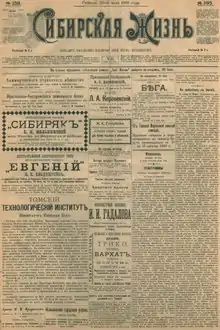
On March 5, 1935, in accordance with the All-Union Central Executive Committee of the USSR, the Institute was named after Sergey Kirov.
In 1940, the Institute was conferred the Order of the Red Banner of Labour.
In 1941-1945 during the period of battles at the Eastern Front of World War II, all research work of the Institute was focused on the development of the arms industry, the assistance to the arms production, including to evacuated industrial enterprises in Tomsk. All research work of universities was coordinated by the Scientists’ Committee formed on June 27, 1941, due to the initiative of a number of professors of Tomsk universities. The Committee contained leading Tomsk scientists, including professors of Kirov Tomsk Industrial Institute (Innokenty Butakov, Innokenty Gebler, Mikhail Korovin). One of the Vice-Chairmen of the Committee was Konstantin Shmargunov, the Rector of the Institute. TPU alumni headed a lot of USSR plants producing tanks and weapons. Timofey Gorbachev, a 1928 alumnus of Dzerzhinsky Siberian Technological Institute, headed the department of the Kuzbassugol Building Complex. Nikolay Kamov, a 1923 alumnus of the Mechanical Faculty of Tomsk Technological Institute, became chief engineer at the Design Bureau producing helicopters. Vladimir Kozhevin, a 1934 alumnus of the Mining Department of Siberian Institute of Mechanical Engineering, from 1941 held a position of a head of the Engineering Office and a deputy chief engineer at the OsinnikiUgol Trust of the Kuzbassugol Building Complex, where coal of the most valuable types required for the metallurgical and defense industries of Russia was produced. In 1942, he was appointed chief engineer and head of mine No. 10 of the OsinnikiUgol Trust. From the moment of Kozhevin’s appointment, the mine became a leading one in Kemerovo Oblast. From 1943 till the end of the battles at the Eastern Front of World War II, the mine maintained the ideals of the USSR State Defense Committee. Valery Kuznetsov, a 1932 alumnus of the Geological Prospecting Faculty of Siberian Institute of Mechanical Engineering, during the years of battles at the Eastern Front of World War II was in charge of drawing geologic maps at the West-Siberian Geology Administration. These maps were required for the exploration of minerals, a necessity in which sharply rose during that period. Grigory Nosov, a 1930 alumnus of Siberian Institute of Mechanical Engineering, took the lead of Magnitogorsk Iron and Steel Works, one of the largest USSR metallurgical enterprises. Over 700 people, including students, academic staff, employees and volunteers went to war. They took part in many battles and only few of them were able to reach Berlin leaving their signatures on the walls of the Reichstag building.
In 1944, the Institute was renamed into Kirov Tomsk Polytechnic Institute.
In 1952, the Institute broadcast the first TV program, which was a movie magazine accompanied by sound. Tomsk became the fourth city in the USSR where television appeared.
In 1957, the Scientific Research Institute of Applied Physics was set up at Kirov Tomsk Polytechnic Institute.
In 1959, the Department of Evening Studies (current Seversk State Technological Academy of National Research Nuclear University MEPhI (Moscow Engineering Physics Institute)) of the TPU Faculty of Physics and Engineering was opened.
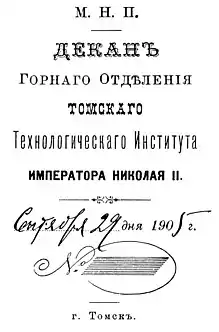
In 1962, Tomsk Institute of Radioelectronics and Electronic Technology was set up based on the TPU Radio Engineering Faculty.
In 1965, a physical start-up of the Sirius Synchrotron with 1.5 eV energy was carried out.
In 1967, the ITR-1000 Nuclear Research Reactor of the Institute was launched.
In 1971, Tomsk Polytechnic Institute was conferred the Order of the October Revolution.
In 1981, the Cybernetics Scientific Training Center was formed at TPU.
On October 18, 1991, the Council of Ministers of the Russian Soviet Federative Socialist Republic adopted resolution No. 552 “On Reorganization of Tomsk Polytechnic Institute into Tomsk Polytechnic University”.
In 1997, TPU became the particularly valuable object of the Russian national heritage of the peoples of the Russian Federation.
In July 2013, the University became one of the contest winners to be awarded the status of Leading Universities of Russia.
On the basis of various faculties, departments and majors of Tomsk Polytechnic University, over 20 free-standing universities in Moscow, Novosibirsk, Omsk, Tomsk, Seversk, Krasnoyarsk, Kemerovo, Barnaul, Chita, Khabarovsk and other Russian cities were opened at different time.
Dmitry Andreevich Sednev, Rector of the university, was suspended by the European University Association (EUA) following support for the 2022 Russian invasion of Ukraine by the Russian Union of Rectors (RUR) in March 2022, for being "diametrically opposed to the European values that they committed to when joining EUA”.[1]
University rectors
The following have been rectors of the university:
- 1899-1907 Efim Zubashev, Rector of Tomsk Technological Institute of Emperor Nicholas II
- 1907-1911 Vladimir Alekseevsky, Rector of Tomsk Technological Institute of Emperor Nicholas II
- 1911-1916 Nikolay Kartashev, Rector of Tomsk Technological Institute of Emperor Nicholas II. Honored Worker of Science and Technology of the Russian Soviet Federative Socialist Republic, recipient of the USSR State Prize
- 1916-1919 Ivan Bobarykov, Rector of Tomsk Technological Institute of Emperor Nicholas II and Tomsk Technological Institute. Honored Worker of Science and Technology of the Russian Soviet Federative Socialist Republic
- 1919-1920 Alexander Ugarov, Rector of Tomsk Technological Institute
- 1920-1921 Yakov Mikhailenko, Rector of Tomsk Technological Institute. Honored Worker of Science and Technology of the Russian Soviet Federative Socialist Republic
- 1921-1930 Nikolay Gutovsky, Rector of Tomsk Technological Institute and Dzerzhinsky Siberian Technological Institute
- 1930-1934 Sergey Kalmykov, Rector of Dzerzhinsky Siberian Technological Institute
- 1934-1936 Alexey Kashkin, Rector of Kirov Tomsk Industrial Institute
- 1936-1937 Alexander Nesterov, Rector of Kirov Tomsk Industrial Institute
- 1937-1938 Dmitry Garshenin, Rector of Kirov Tomsk Industrial Institute
- 1939-1944 Konstantin Shmargunov, Rector of Kirov Tomsk Industrial Institute
- 1944-1970 Alexander Vorobyev, Rector of Kirov Tomsk Polytechnic Institute. Honored Worker of Science and Technology of the Russian Soviet Federative Socialist Republic, corresponding member of the Academy of Pedagogical Sciences
- 1970-1981 Ivan Kalyatsky, Rector of Kirov Tomsk Polytechnic Institute
- 1981-1990 Ivan Chuchalin, Rector of Kirov Tomsk Polytechnic Institute. Honored Worker of Science and Technology of the Russian Soviet Federative Socialist Republic
- 1990-2008 Yury Pokholkov, Rector of Tomsk Polytechnic Institute and Tomsk Polytechnic University. Honored Worker of Science and Technology of the Russian Federation
- 2009-2019 Petr Chubik, Rector of National Research Tomsk Polytechnic University
- 2019-2020 Victor Demin, Acting Rector of National Research Tomsk Polytechnic University
- 2020-2021 Andrey Yakovlev, Acting Rector of National Research Tomsk Polytechnic University
- 2021 to present Dmitry Sednev, Acting Rector of National Research Tomsk Polytechnic University
Rankings
| Versions of rankings | In Russia | In Europe | In the world | Year |
|---|---|---|---|---|
| Russian university ranking (Expert RA ranking agency) | 7 | 2013 | ||
| Classbase | 16 | 510 | 1379 | 2013 |
| Entire Education | 10 | 2012 | ||
| Web of World Universities | 12 | 2013 | ||
| QS World University Rankings | 501-550 | 2014 | ||
| Vladimir Potanin Foundation | 4 | 2012 | ||
| SCImago | 19 | 142 | 2421 | 2012 |
| 2012 National Ranking of Universities (a joint project of the Interfax news agency and the Echo of Moscow radio station) | 9 | 2012 | ||
| 2011 National Ranking of Universities (a joint project of the Interfax news agency and the Echo of Moscow radio station) | 9 | 2011 | ||
| Ministry of Education and Science of the Russian Federation | 2 | 2008 | ||
| GlobalWorldCommunicator (GWC) | 2 | 146 | 2016 | |
| 2020 Forbes 100 Best Russian Universities | 7 | 2020 |
Academic profile
Tomsk Polytechnic University offers
- 29 bachelor’s degree programs;
- 32 master’s degree programs;
- 9 specialist degree programs;
- 19 postgraduate programs;
- 31 research degrees.
 TPU main building
TPU main building
In 2017, TPU institutes were transformed into engineering and research schools:
- School of Computer Science and Robotics;
- School of Non-Destructive Testing;
- School of Advanced Manufacturing Technologies;
- School of Earth Sciences and Engineering;
- School of Energy and Power Engineering;
- School of Nuclear Science and Engineering;
- Research School of High-Energy Physics;
- Research School of Chemistry and Applied Biomedical Sciences;
- School of Core Engineering Education;
- School of Engineering Entrepreneurship.
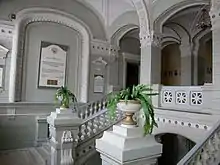
- Yurga Institute of Technology (Yurga campus)
Yurga Institute of Technology (Yurga campus) of Tomsk Polytechnic University was set up as a result of a number of transformations: the Study Support Center (1957), the Mechanical Engineering Faculty (1987), a TPU affiliate in Yurga (1993) and Yurga Institute of Technology (1993). The institute trains engineers for Kemerovo Oblast. The problem of training engineers was always solved in cooperation with Yurga Machine-Building Plant. The plant jointly with the institute solves the problem of training practice-oriented engineers for machinery production.
Students are trained at 10 departments of the institute where eight out of them are graduate departments.
The institute contains over 1,500 students studying full-time, part-time or remotely. The institute includes eight academic and laboratory buildings with over 70 laboratories equipped with the most up-to-date devices and tools.
- Center of Academic Geology Internships
The Center of Academic Geology Internships is located on the shore of Lake Sobachie in Khakassia. The Center was set up in 1959. It is used for completing geology internships at universities of Western Siberia.
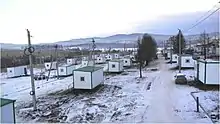
- ITR-1000 Nuclear Research Reactor
The IRT-1000 Nuclear Research Reactor was constructed in 1959-1967. Annually, over 430 students complete training at the Reactor. They obtain practical expertise on control of a nuclear installation, ensuring the physical protection of nuclear facilities, nuclear safety and security, as well as radiation safety. Among all Russian operating reactors, only in Tomsk, at the TPU Reactor, international students are able to complete training. They are trained to work at nuclear facilities in their home countries.
Research
Research at Tomsk Polytechnic University is developed in various areas:
- High-energy physics;
- Chemistry and applied biomedical sciences;
- Non-destructive testing;
- Earth sciences and engineering;
- Advanced manufacturing technologies;
- Intelligent energy;
- Nuclear science and engineering.
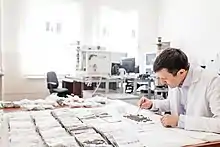 TPU scientists search for a new technology for the production of unconventional Paleozoic oil
TPU scientists search for a new technology for the production of unconventional Paleozoic oil
International cooperation
TPU is a member of CESAER and an associated member of CLUSTER. The university develops bilateral cooperation with 23 out of 57 CESAER university members and with 9 out of 12 CLUSTER university members.
Among the main business partners of the university, there are Schlumberger Limited (France), SwissGeoPower AG (Switzerland), Smiths Heimann GmbH (Germany), JME Ltd. (Great Britain) and others.
TPU researchers conduct research projects within the grant programs of the European Commission Seventh Framework Programme (FP7), Horizon 2020, Erasmus Programme and others. Tomsk Polytechnic University enters top-10 Russian academic institutions to attract international scientists.
TPU students have an opportunity to obtain higher education abroad within programs of academic exchange, master’s double degree programs at partner universities and network programs. Over 500 TPU students annually complete training at foreign universities.
Notable alumni, students and faculty
- Mikhail Mil (did not graduate), helicopter designer, the founder of the Mil Moscow Helicopter Plant
- Nikolay Kamov, famous helicopter designer
- Alexander Kazantsev, science fiction writer
- Kanysh Satpayev, one of the founders of Soviet metallogeny
- Nikolay Urvantsev, geologist and Arctic explorer
- Gennady Mesyats, physicist, founder of several scientific schools
- Fritz Noether, German-born mathematician, faculty
- Nikolay Nikitin, structural designer and construction engineer
- Matvei Kapelyushnikov, mechanical engineer and inventor
- Vyacheslav Nagovitsyn, politician
- Ivan Indinok, politician
- Oleg Minin, physicist, faculty
- Igor Minin, physicist, faculty
- Nikolay Semyonov, physicist and chemist
- Mikhail Usov, geologist
- Theodor Molien, Baltic-German mathematician, faculty
- Andrey Kryachkov, architect, faculty
- Sergey Psakhie, physicist, faculty
- Antonina Pirozhkova, civil engineer and writer
Gallery
 TPU main building
TPU main building TPU academic building No. 1 (building of the former Mining Department)
TPU academic building No. 1 (building of the former Mining Department) TPU academic building No. 3 (building of the former Physical Department)
TPU academic building No. 3 (building of the former Physical Department) TPU academic building No. 10
TPU academic building No. 10 Memorial to TPU fallen staff during the period of battles at the Eastern Front of World War II
Memorial to TPU fallen staff during the period of battles at the Eastern Front of World War II.jpg.webp) The TPU campus is recognized the best in Russia (2016 contest by the Ministry of Education and Science of the Russian Federation)
The TPU campus is recognized the best in Russia (2016 contest by the Ministry of Education and Science of the Russian Federation) TPU Science and Technical Library, 2020
TPU Science and Technical Library, 2020 TPU Science Park
TPU Science Park TPU Science Park and academic building No. 11
TPU Science Park and academic building No. 11 TPU academic building No. 10
TPU academic building No. 10
References
- O’Malley, Brendan (7 March 2022). "EUA suspends 12 Russian members who back Putin's invasion". University World News. Retrieved 18 April 2022.
External links
| Wikimedia Commons has media related to Tomsk Polytechnical University. |
- Tomsk Polytechnic University (in English)
- Tomsk Polytechnic University Tour Video (in English)